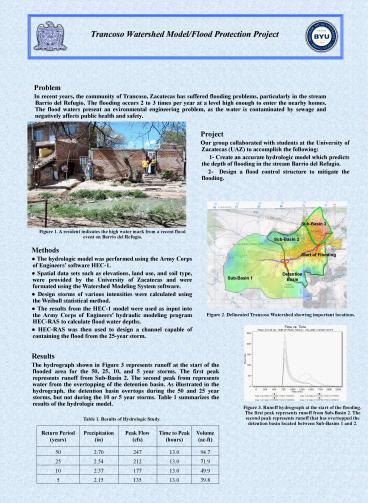Trancoso Watershed Model/Flood Protection Project - PowerPoint PPT Presentation
Title:
Trancoso Watershed Model/Flood Protection Project
Description:
Trancoso Watershed Model/Flood Protection Project Problem In recent years, the community of Trancoso, Zacatecas has suffered flooding problems, particularly in the ... – PowerPoint PPT presentation
Number of Views:45
Avg rating:3.0/5.0
Title: Trancoso Watershed Model/Flood Protection Project
1
Trancoso Watershed Model/Flood Protection
Project
Problem In recent years, the community of
Trancoso, Zacatecas has suffered flooding
problems, particularly in the stream Barrio del
Refugio. The flooding occurs 2 to 3 times per
year at a level high enough to enter the nearby
homes. The flood waters present an evironmental
engineering problem, as the water is contaminated
by sewage and negatively affects public health
and safety.
Project Our group collaborated with students at
the University of Zacatecas (UAZ) to accomplish
the following 1- Create an accurate
hydrologic model which predicts the depth of
flooding in the stream Barrio del Refugio.
2- Design a flood control structure to mitigate
the flooding.
Sub-Basin 3
Figure 1. A resident indicates the high water
mark from a recent flood event on Barrio del
Refugio.
Sub-Basin 2
Methods ? The hydrologic model was performed
using the Army Corps of Engineers software
HEC-1. ? Spatial data sets such as elevations,
land use, and soil type, were provided by the
University of Zacatecas and were formated using
the Watershed Modeling System software. ? Design
storms of various intensities were calculated
using the Weibull statistical method. ? The
results from the HEC-1 model were used as input
into the Army Corps of Engineers hydraulic
modeling program HEC-RAS to calculate flood water
depths. ? HEC-RAS was then used to design a
channel capable of containing the flood from the
25-year storm.
Start of Flooding
Detention Basin
Sub-Basin 1
Figure 2. Delineated Trancoso Watershed showing
important locations.
Results The hydrograph shown in Figure 3
represents runoff at the start of the flooded
area for the 50, 25, 10, and 5 year storms. The
first peak represents runoff from Sub-Basin 2.
The second peak from represents water from the
overtopping of the detention basin. As
illustrated in the hydrograph, the detention
basin overtops during the 50 and 25 year storms,
but not during the 10 or 5 year storms. Table 1
summarizes the results of the hydrologic model.
Figure 3. Runoff hydrograph at the start of the
flooding. The first peak represents runoff from
Sub-Basin 2. The second peak represents runoff
that has overtopped the detention basin located
between Sub-Basins 1 and 2.
Table 1. Results of Hydrologic Study.
Return Period (years) Precipitation (in) Peak Flow (cfs) Time to Peak (hours) Volume (ac-ft)
50 2.70 247 13.0 94.7
25 2.54 212 13.0 71.9
10 2.37 177 13.0 49.9
5 2.15 135 13.0 39.8
2
Trancoso Watershed Model/Flood Protection
Project
- Hydraulic Model Results
- The following figure shows the level of the flood
waters given a 5, 10, 25, and 50 year storm at
peak flow. As seen, the 50 years storm
experiences flood water depths as high as 2.5
meters. The surface was generated using survey
data. In most places, the channel is 20 to 30
meters wide, though in a few places it is smaller.
2185
2180
2164.4
2164.2
2164.0
2175
Elevation (m)
2163.8
Elevation (m)
2163.6
2170
2163.4
2163.2
2165
2163.0
1
2
3
4
5
0
Station (m)
2160
200
400
600
800
1000
1200
Channel Distance (m)
Channel Design A channel was designed to contain
the peak flow from the 25-year storm. Multiple
channel sizes, shapes, and slopes were run
through HEC-RAS to find a preferred channel
design. Engineering Disciplines This project
included the following engineering discplines
1- Water Resorces. Calculating the quantity of
water of the flood water depths. 2-
Geotechnical. Reading soils maps that indicate
soil composition and assigning a corresponding
hydrologic soil type. 3- Transportation. The
current wash is used as a pedestrian walkway. The
proposed channel leaves enough room on both sides
of the channel to allow pedestrian
passage. Realistic Constraints This project
included the following constraints 1-
Economic. The Mexican city of Trancoso does not
have much funding for civil engineering projects.
A more complete solution, including a second
detention basin at the start of the flooding
zone, is not feasible, because of the high cost
of re-routing roads or removing buildings. 2-
Social/Cultural. The homes on either side of the
channel are in the 5-year floodplain. The most
effective way to mitigate such a flooding problem
would be to exercise eminent domain to buy the
homes then relocate the residents. The homes are
of low quality and are already badly damaged by
reoccuring floods. This option, though logical,
did not fit within the social/cultural
constraints of Mexico. One Mexican government
disaster responder expalined that if the
government relocates the people to new houses,
the people would sell them and move back to the
old abandoned houses near the dry stream. For
this reason, our design solution could not
relocate a single home.































